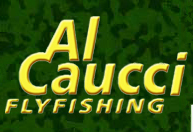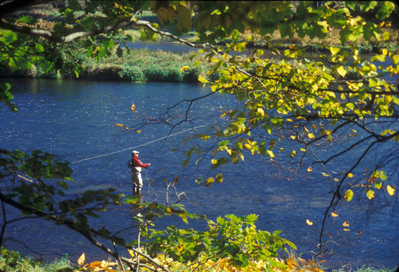
![]()
Trips
Montana
Missouri
SW
Montana
Clark Fork & Bitterroot
Bahamas
Andros Island
Upper Delaware
Other Destinations
Alaska
New Zealand
Argentina
Chile
![]()
News
![]()
River Updates
Hatch
Chart
![]()
Campground
![]()
Tips
Articles
ACFF
Photo Gallery
![]()
Al Caucci's Biography
Testimonials
![]()
Contact Us
Home
![]()
Your fishing logs at Ecolure
![]()
Friends of the
Upper
Delaware
![]()
1250 Winterdale Road
Starlight, PA, 18461
Phone : 1 ( 570 ) 635 - 5897
email : alcaucci@hancock.net

|
|||
|
Fall on the Delaware By Al Caucci
Toward the end of September and October there's a crispness in the air that clears the head and livens your step. The trees along the river banks start to change. Emerald green leaves of summer turn to yellow, blazing orange and red. Rivers run low, cold and gin clear in the bright sun, reflecting brightly colored trees and making it difficult to see your fly on the water. Mayflies hatch and the trout rise-it's a great time to be alive and fishing. When I think of autumn, I think of large Isonychia duns, cream Stenonemas, small Baetis and tiny Pseudocloeon mayflies, but I also have a warm spot in my heart for the autumn Heptagenia mayflies. I have fond memories of hooking wild rainbows and browns on those broad productive flats of the West Branch of the Delaware. I use a size 18 Comparadun with a greenish yellow body and a pale deer hair wing to imitate the dun of the Heptagenia hebe mayfly (now called Lucrocuta hebe). The emerger is deadly if the duns are being blown on the surface. On cold or rainy days with little wind, the duns float the current a long time before take-off and trout sip them leisurely. Here, the Comparadun is unequalled. The small Heptagenia flies, the large Isonychia and tiny Pseudocloeon mayflies are staples for autumn trout fishing on the Upper Delaware. They are also found on many streams in the East and Midwest in good numbers, where they are very important. Western rivers boast two important autumn Heptagenia mayflies. H. solitaria and simplicioides (now called Lucrocuta simplicioides). Both are similar to the Stenonema mayflies (light Cahill) of the East and cause excellent dry fly fishing on Western rivers. Approximately 10mm (size 12 and 14 hooks) in size, these mayflies cause good feeding by trout. Owing to their size, they are easy to fish and create a pleasant change from the smaller flies that hatch this time of the year. A Comparadun tied with a tan body and a pale deer hair wing is an excellent choice for this hatch, as is the parachute tied in the same colors. Compara-emergers are also deadly during this activity. Comparaspinners or poly spinners should be tied with tan bodies and wings to imitate the dying spinners. On rich rivers, wild trout seldom take fullhackled imitations because they don't portray a vulnerable insect stuck in the surface film. The Heptagenia (and Lucrocuta) nymphs have three tails and are similar to those of Stenonema and Stenocron, but less flattened (more slender). Their plate-like gills on abdominal segments one through seven resemble those of Baetis, rather than those of Stenocron. The adults have two tails and also resemble the Stenos, but they have no conspicuous dark bands on the femur (the thickest leg section, similar to a thigh), which is the trademark of the Stenos. Also, the wings of the dun are similar to the Stenos, having dark but blurred cross veins. As a spinner, the cross veins are visible in the clear wings, but less prominent than the cross veins of the Stenos. Heptagenia habitat is the moderate to rapid sections of rivers and streams. The nymphs migrate to slower sections prior to emergence, much like the sulphur (Ephemerella dorothea) nymphs. Autumn is a perfect time to fly fish. Great weather, spectacular colors, few anglers and plenty of rising trout. Go ahead, give it a try. I'm sure you'll become addicted, just like me.
|
|||
